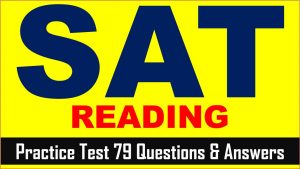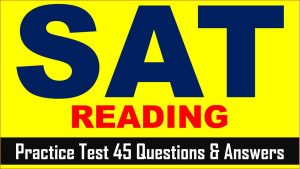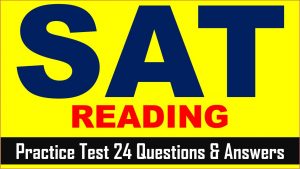SAT (Scholastic Assessment Test) is a standard test, used for taking admission to undergraduate programs of universities or colleges of the United States. SAT is developed and published by the College Board, an organization in the United States, administered by the Educational Testing Service. In this article of AKVTutorials, you will get SAT Practice Reading Passage Test 36 | SAT 2024 Online Tutor AMBiPi.
SAT Reading Practice Passage
This passage is from Carlos Ruiz Zafón, The Angel’s Game. ©2008 by Dragonworks, S.L. Translation ©2009 by Lucia Graves. The narrator, a writer, recalls his childhood in early twentieth-century Barcelona.
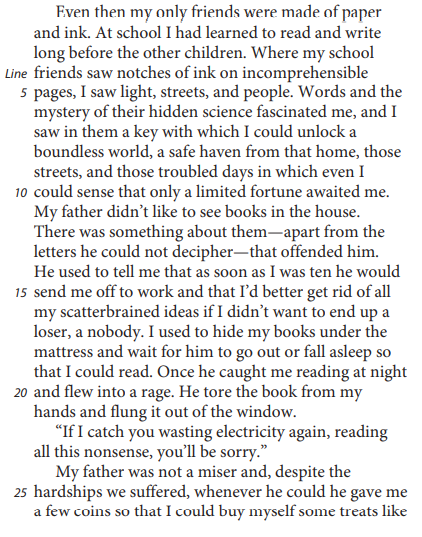
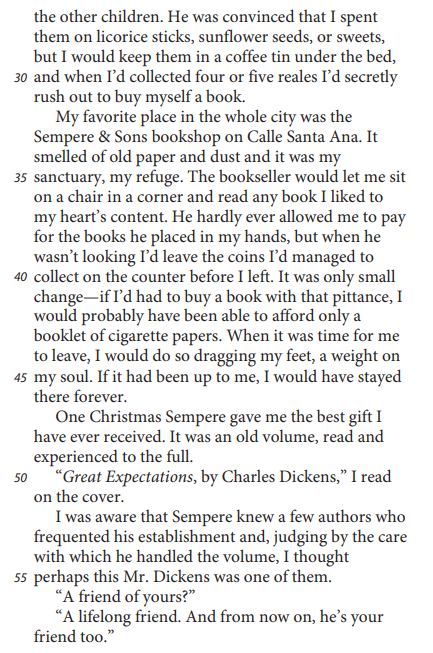
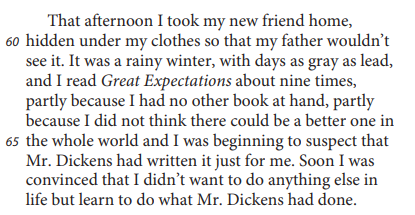
SAT Reading Comprehension Practice Test Questions
SAT Practice Test 36 Question No 1
Throughout the passage, the main focus shifts from a
Option A: general discussion of the narrator’s love of reading to a portrayal of an influential incident.
Option B: depiction of the narrator’s father to an examination of an author with whom the narrator becomes enchanted.
Option C: a symbolic representation of a skill the narrator possesses to an example of its application.
Option D: a tale about the hardships of the narrator’s childhood to an analysis of the effects of those hardships.
SAT Practice Test 36 Answer No 1
Show/Hide Answer
Option A :
The first paragraph explains the narrator’s love of reading: “Even then my only friends were made of paper and ink. . . . Where my school friends saw notches of ink on incomprehensible pages, I saw light, streets, and people.” The fourth paragraph reiterates this love in its description of the bookshop as a “sanctuary” and “refuge.” The shift in focus occurs in the last six paragraphs, which recount the gift of a book that transforms the narrator’s love of reading into a desire to write: “I did not think there could be a better [book] in the whole world and I was beginning to suspect that Mr. Dickens had written it just for me. Soon I was convinced that I didn’t want to do anything else in life but learn to do what Mr. Dickens had done.” Thus the passage’s overall focus shifts from the narrator’s love of reading to a specific incident that influences his decision to become a writer.
Choice B is incorrect because the passage never focuses on the narrator’s father, who primarily serves to illustrate the narrator’s determination to read books despite all obstacles. Choice C is incorrect because the passage focuses on the narrator’s desire to write rather than on whatever skill he may have as a writer. Choice D is incorrect because the passage doesn’t make the narrator’s childhood hardships its central focus or analyze the effects of those hardships.
SAT Practice Test 36 Question No 2
The main purpose of lines 1-10 (“Even… awaited me”) is to
Option A: introduce the characters who play a part in the narrator’s story.
Option B: list the difficult conditions the narrator endured in childhood.
Option C: describe the passion that drives the actions the narrator recounts.
Option D: depict the narrator’s aspirations before he met Sempere.
SAT Practice Test 36 Answer No 2
Show/Hide Answer
Option C :
In the first paragraph, the third sentence describes the narrator’s love of reading (“where my school friends saw notches of ink on incomprehensible pages, I saw light, streets, and people”), and the fourth sentence describes the role that reading played in the narrator’s life (“a safe haven from that home, those streets, and those troubled days in which even I could sense that only a limited fortune awaited me”). The remainder of the passage recounts incidents in which the narrator’s actions arise from his love of, and dependence on, reading. Thus the third and fourth sentences can be seen describing a passion that accounts for those actions.
Choice A is incorrect because although the narrator’s “school friends” are mentioned in passing in the third sentence, they aren’t introduced as proper characters and make no further appearance in the passage. Choice B is incorrect because the passage doesn’t list the difficult conditions of the narrator’s childhood until after these sentences. Choice D is incorrect because the narrator’s aspirations aren’t discussed until the last paragraph of the passage.
SAT Practice Test 36 Question No 3
With which of the following statements about his father would the narrator most likely agree?
Option A: He lacked affection for the narrator.
Option B: He disliked any unnecessary use of money.
Option C: He would not have approved Sempere’s gift.
Option D: He objected to the writings of Charles Dickens.
SAT Practice Test 36 Answer No 3
Show/Hide Answer
Option C :
The tenth paragraph shows that upon returning home, the narrator hides the gift (the “new friend”) that Sempere had given him: “That afternoon I took my new friend home, hidden under my clothes so that my father wouldn’t see it.” It can be inferred from this sentence that the narrator’s concern arises from an awareness that his father would disapprove of the gift.
Choice A is incorrect because although the passage discusses the father’s hostility toward the narrator’s love of reading, there is no indication that the father is not affectionate to the narrator more generally; indeed, the third paragraph depicts the father’s generosity toward the narrator. Choice B is incorrect because the father’s generosity toward the narrator, as depicted in the third paragraph, clearly shows that the father encourages unnecessary purchases of such things as candy. Choice D is incorrect because although the first paragraph shows that the father is hostile toward books in general, there is no indication in the passage that Dickens or any other author is a specific object of the father’s disdain.
SAT Practice Test 36 Question No 4
Which choice provides the best evidence for the answer to the previous question?
Option A: Lines 24-27 (“My father… children”)
Option B: Lines 35-37 (“The bookseller… content”)
Option C: Lines 37-38 (“He hardly… hands”)
Option D: Lines 59-61 (“That afternoon…see it”)
SAT Practice Test 36 Answer No 4
Show/Hide Answer
Option D :
The previous question asks which statement about the narrator’s father would the narrator most likely agree with. The answer, that his father wouldn’t have approved of Sempere’s gift to the narrator, is best supported in the tenth paragraph: “That afternoon I took my new friend home, hidden under my clothes so that my father wouldn’t see it.” It can be inferred from this sentence that the narrator is aware of his father’s likely disapproval of the gift (the “new friend”).
Choices A, B, and C are incorrect because the cited lines don’t support the answer to the previous question. Instead, they show the father giving his own gift to the narrator (choice A) and illustrate how the narrator was treated when in Sempere’s bookshop (choices B and C).
SAT Practice Test 36 Question No 5
It can reasonably be inferred from the passage that the main reason that the narrator considers Great Expectations to be the best gift he ever received is because
Option A: reading the book convinced him that he wanted to be a writer.
Option B: he’d only ever been given sweets and snacks as gifts in the past.
Option C: the gift meant that Sempere held him in high regard.
Option D: Sempere was a friend of the book’s author.
SAT Practice Test 36 Answer No 5
Show/Hide Answer
Option A :
The last paragraph makes clear the narrator’s enthusiasm for Charles Dickens’s Great Expectations, and it can be inferred from the last sentence of this paragraph that this enthusiasm motivated the narrator to aspire to a career as a writer: “Soon I was convinced that I didn’t want to do anything else in life but learn to do what Mr. Dickens had done.”
Choice B is incorrect because the passage doesn’t discuss gifts the narrator has received in the past; although the father sometimes gave the narrator money to buy sweets and snacks, these weren’t gifts since the narrator made the purchases himself. Choice C is incorrect because although it is clear from the passage that Sempere was kind and even indulgent to the narrator, there is no suggestion that this treatment was inspired by respect for the narrator. Choice D is incorrect because there is no suggestion that the narrator took Sempere’s figurative designation of Dickens as a “lifelong friend” in the ninth paragraph to be a literal statement.
SAT Practice Test 36 Question No 6
Which choice provides the best evidence for the answer to the previous question?
Option A: Lines 38-40 (“when… left”)
Option B: Lines 48-49 (“It was… full”)
Option C: Lines 52-55 (“I was… them”)
Option D: Lines 66-68 (“Soon… done”)
SAT Practice Test 36 Answer No 6
Show/Hide Answer
Option D :
The previous question asks why the narrator considers Great Expectations to be the greatest gift he ever received. The answer, that the book convinced him to become a writer, is best supported by the last sentence of the last paragraph: “Soon I was convinced that I didn’t want to do anything else in life but learn to do what Mr. Dickens had done.”
Choices A, B, and C are incorrect because the cited lines don’t support the answer to the previous question. Instead, they explain the narrator’s interactions with the bookseller (choice A), describe the book’s physical condition (choice B), and indicate the narrator’s initial, erroneous assumption that Sempere knew Charles Dickens personally(choice C).
SAT Practice Test 36 Question No 7
The narrator indicates that he pays Sempere
Option A: less than Sempere expects him to pay for the books.
Option B: nothing, because Sempere won’t take his money.
Option C: the money he makes selling sweets to the other children.
Option D: much less for the books than they are worth.
SAT Practice Test 36 Answer No 7
Show/Hide Answer
Option D :
In the fourth paragraph, the narrator explains that although Sempere normally didn’t charge him for books, he still left Sempere a few coins as payment: “It was only small change—if I’d had to buy a book with that pittance, I would probably have been able to afford only a booklet of cigarette papers.” These lines signal the narrator’s awareness that he was paying less for the books than they were worth.
Choice A is incorrect because the passage states that Sempere didn’t expect or want the narrator to pay: “He hardly ever allowed me to pay for the books.” Choice B is incorrect because the fourth paragraph makes clear that even if Sempere didn’t want the narrator’s money, the narrator would still “leave the coins I’d managed to collect.” Choice C is incorrect because the third paragraph states that the money with which the narrator paid Sempere was originally given to the narrator by his father.
SAT Practice Test 36 Question No 8
As used in line 44, “weight” most nearly means
Option A: bulk.
Option B: burden.
Option C: force.
Option D: clout.
SAT Practice Test 36 Answer No 8
Show/Hide Answer
Option B :
In the fourth paragraph, the narrator describes his reluctance to leave Sempere’s bookshop: “When it was time for me to leave, I would do so dragging my feet, a weight on my soul.” In this context, “weight” most nearly means burden.
Choices A, C, and D are incorrect because in the context of the narrator having to do something he doesn’t want to, a “weight” he had to carry most nearly means a burden, not a bulk (choice A), force (choice C), or clout (choice D).
SAT Practice Test 36 Question No 9
The word “friend” is used twice in lines 57-58 to
Option A: underline the importance of the narrator’s connection to Sempere.
Option B: stress how friendships helped the narrator deal with his difficult home situation.
Option C: emphasize the emotional connection Sempere feels to reading.
Option D: imply that the narrator’s sentiments caused him to make an irrational decision.
SAT Practice Test 36 Answer No 9
Show/Hide Answer
Option C :
When, in the eighth paragraph, the narrator asks Sempere if the author Charles Dickens is a friend of his, Sempere replies, in the ninth paragraph, that Dickens is a “lifelong friend. And from now on, he’s your friend too.” Sempere designated Dickens a “friend” of both himself and the narrator, who had never heard of the author before. This signals that the use of “friend” in these lines is figurative and emphasizes Sempere’s emotional connection to Dickens and, more generally, to reading. It also signals Sempere’s hope that the narrator will come to have a similar connection to Dickens.
Choices A, B, and D are incorrect because the word “friend” is used in these lines to emphasize Sempere’s connection to reading, rather than his connection to the narrator (choice A), the narrator’s relationships or home life (choice B), or the narrator’s emotional state or decision making (choice D).
SAT Practice Test 36 Question No 10
Which statement best characterizes the relationship between Sempere and Charles Dickens?
Option A: Sempere models his writing after Dickens’s style.
Option B: Sempere is an avid admirer of Dickens’s work.
Option C: Sempere feels a personal connection to details of Dickens’s biography.
Option D: Sempere considers himself to be Dickens’s most appreciative reader.
SAT Practice Test 36 Answer No 10
Show/Hide Answer
Option B :
In the ninth paragraph, Sempere describes the author Charles Dickens to the narrator: “A lifelong friend. And from now on, he’s your friend too.” As the reader can reasonably assume that Sempere doesn’t actually know Dickens, this description can be read as signaling Sempere as an avid admirer of Dickens’s work.
Choice A is incorrect because the passage describes Sempere as a bookseller, not a writer. Choice C is incorrect because although the passage implies Sempere feels an emotional connection to Dickens, it doesn’t suggest that this connection arises from any similarity between Sempere’s life and that of Dickens. Choice D is incorrect because even if the passage implies that Sempere admires Dickens’s work, Sempere’s admiration isn’t discussed in relation to that felt by other readers of Dickens, nor is Sempere shown to compare himself to other such readers.

